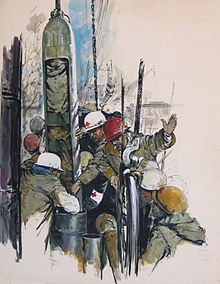
On 7 November 1963, 11 West German miners were rescued from a collapsed mine after surviving for 14 days, an event that later became known as the Wunder von Lengede ("miracle of Lengede").
On 24 October 1963, the Lengede-Broistedt Iron Mine near Salzgitter was flooded with 500,000 cubic metres (18,000,000 cu ft) of muddy water after a sedimentation pond had broken its ground and the tunnels between the 60-metre (200 ft) and 100 m (330 ft) levels. Out of 129 workers, 79 escaped during the first few hours. They used underground mine ventilation raises and further shafts which had been provided with ladders due to safety regulations. At first there seemed to be no hope for the remaining 50 miners. Several attempts and deliberations about possible rescue positions within the mine and the successful rescue of miners at the one or other locations gave rise to a sequence of dramatic and technically challenging rescue missions with hitherto unseen worldwide media coverage.